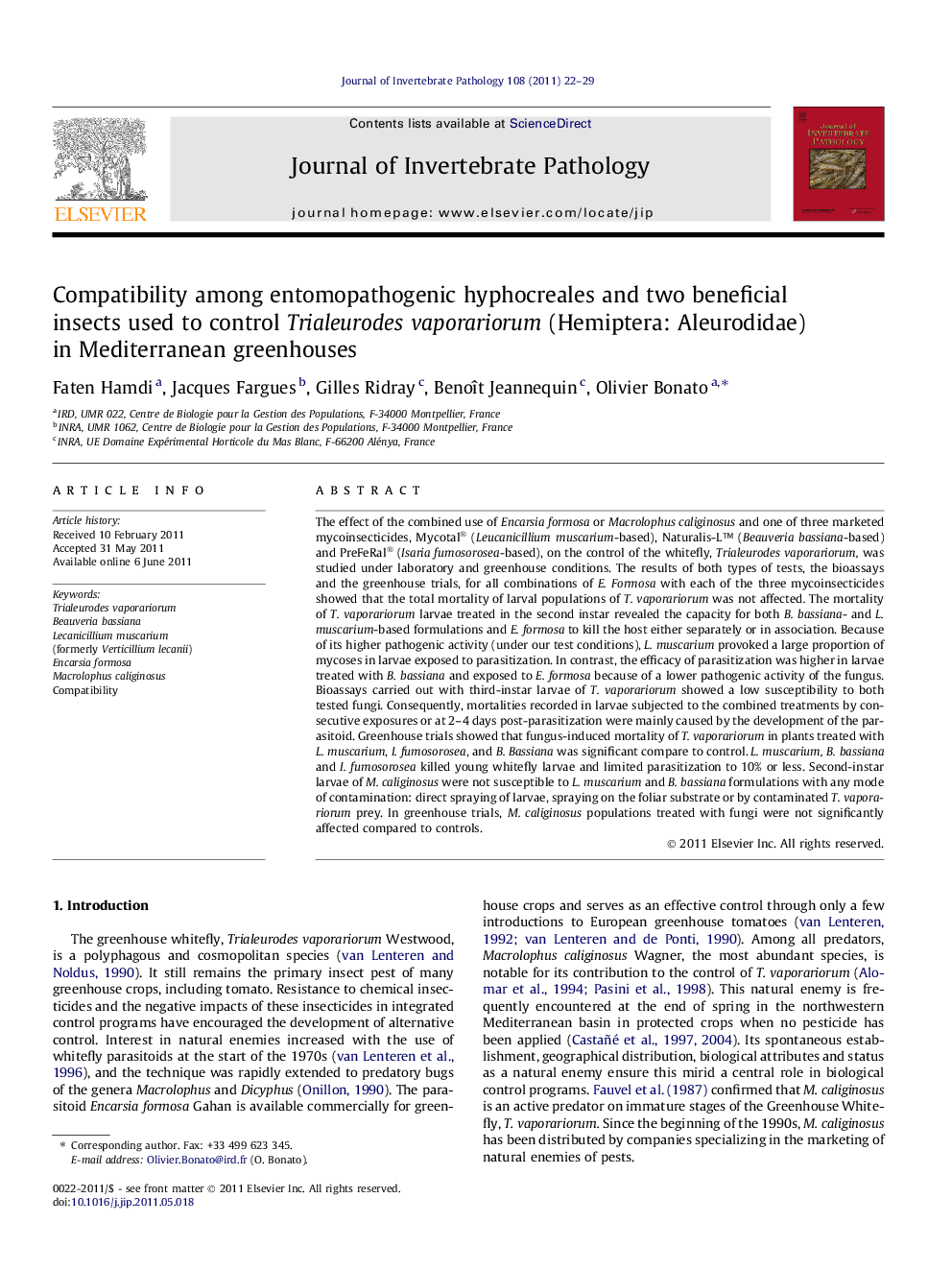| Article ID | Journal | Published Year | Pages | File Type |
|---|---|---|---|---|
| 4558150 | Journal of Invertebrate Pathology | 2011 | 8 Pages |
The effect of the combined use of Encarsia formosa or Macrolophus caliginosus and one of three marketed mycoinsecticides, Mycotal® (Leucanicillium muscarium-based), Naturalis-L™ (Beauveria bassiana-based) and PreFeRal® (Isaria fumosorosea-based), on the control of the whitefly, Trialeurodes vaporariorum, was studied under laboratory and greenhouse conditions. The results of both types of tests, the bioassays and the greenhouse trials, for all combinations of E. Formosa with each of the three mycoinsecticides showed that the total mortality of larval populations of T. vaporariorum was not affected. The mortality of T. vaporariorum larvae treated in the second instar revealed the capacity for both B. bassiana- and L. muscarium-based formulations and E. formosa to kill the host either separately or in association. Because of its higher pathogenic activity (under our test conditions), L. muscarium provoked a large proportion of mycoses in larvae exposed to parasitization. In contrast, the efficacy of parasitization was higher in larvae treated with B. bassiana and exposed to E. formosa because of a lower pathogenic activity of the fungus. Bioassays carried out with third-instar larvae of T. vaporariorum showed a low susceptibility to both tested fungi. Consequently, mortalities recorded in larvae subjected to the combined treatments by consecutive exposures or at 2–4 days post-parasitization were mainly caused by the development of the parasitoid. Greenhouse trials showed that fungus-induced mortality of T. vaporariorum in plants treated with L. muscarium, I. fumosorosea, and B. Bassiana was significant compare to control. L. muscarium, B. bassiana and I. fumosorosea killed young whitefly larvae and limited parasitization to 10% or less. Second-instar larvae of M. caliginosus were not susceptible to L. muscarium and B. bassiana formulations with any mode of contamination: direct spraying of larvae, spraying on the foliar substrate or by contaminated T. vaporariorum prey. In greenhouse trials, M. caliginosus populations treated with fungi were not significantly affected compared to controls.
Graphical abstractThe effect of the combined use of Encarsia formosa or Macrolophus caliginosus and one of three marketed mycoinsecticides, Mycotal® (Leucanicillium muscarium-based), Naturalis-L™ (Beauveria bassiana-based) and PreFeRal® (Isaria fumosorosea-based), on the control of the whitefly, Trialeurodes vaporariorum, was studied under laboratory and greenhouse conditions. Beauveria bassiana and Leucanicilium muscarium-based formulations and E. formosa kill T. vaporariorum larvae either separately or in association. Leucanicilium muscarium provoked a large proportion of mycoses in larvae exposed to parasitization. The efficacy of parasitization was higher in larvae treated with B. bassiana and exposed to E. formosa because of a lower pathogenic activity of the fungus. Bioassays showed a low susceptibility of third-instar larvae of T. vaporariorum to both tested fungi. Macrolophus caliginosus were not susceptible to L. muscarium and B. bassiana formulations in both laboratory or greenhouse conditions.Figure optionsDownload full-size imageDownload as PowerPoint slideHighlights► Beauveria bassiana, Leucanicillium muscarium and Encarsia formosa kill Trialeurodes vaporariorum in association or not. ► Efficacy of parasitization was higher in larvae treated with B. bassiana and exposed to E. formosa. ► Third- instar larvae of T. vaporariorum showed a low susceptibility to tested fungi. ► Macrolophus caliginosus were not susceptible to L. muscarium and B. bassiana formulations.
